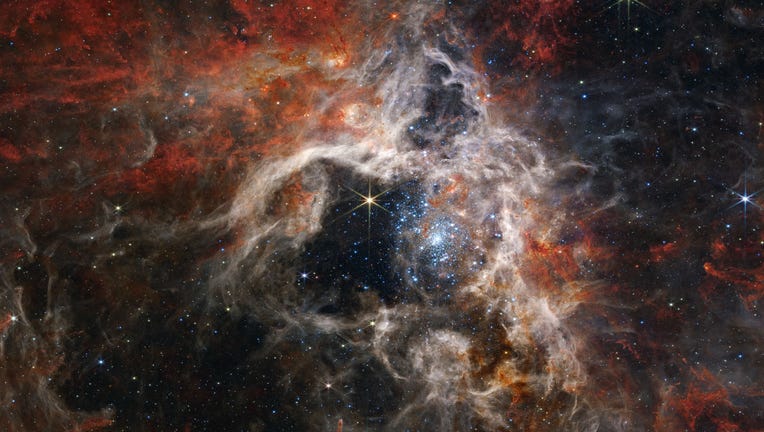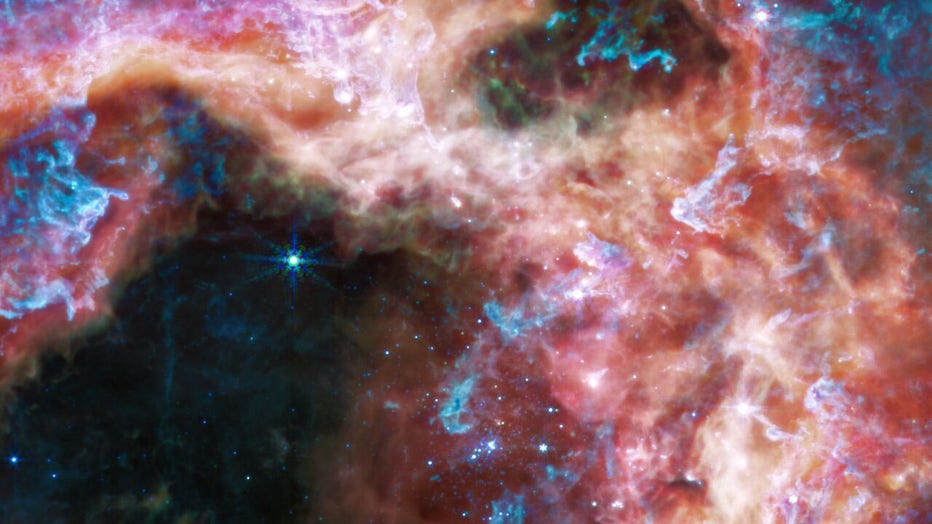NASA’s James Webb Space Telescope captures 'cosmic tarantula' in new image

In this mosaic image stretching 340 light-years across, Webb’s Near-Infrared Camera (NIRCam) displays the Tarantula Nebula star-forming region in a new light, including tens of thousands of never-before-seen young stars that were previously shrouded
NASA’s James Webb Space Telescope continues to capture eye-popping images of the cosmos, with its latest showing fantastic detail of thousands of young stars spotted in a stellar nursery nicknamed the "Tarantula Nebula."
A stellar nursery is an area of outer space within a dense nebula in which gas and dust are contracting, resulting in the formation of stars. The Tarantula Nebula received its spidery nickname for the appearance of its dusty filaments in previous telescope images, according to NASA.
Also called 30 Doradus, the Tarantula Nebula is located 161,000 light-years away from Earth in the Large Magellanic Cloud galaxy. It’s home to the hottest, most massive stars known, according to the agency.
In addition to the young stars, JWST’s new image revealed distant background galaxies, as well as the detailed structure and composition of the nebula’s gas and dust, NASA explained in a post titled, "A Cosmic Tarantula, Caught by NASA’s Webb.
The $10 billion space telescope uses an infrared light spectrum that allows it to see through the cosmic dust and see faraway light from the corners of the universe.

At the longer wavelengths of light captured by its Mid-Infrared Instrument (MIRI), Webb focuses on the area surrounding the central star cluster and unveils a very different view of the Tarantula Nebula. In this light, the young hot stars of the clus
NASA said one of the reasons the Tarantula Nebula is of interest to astronomers is because the nebula has a similar type of chemical composition as the gigantic star-forming regions observed when the universe was only a few billion years old and star formation was at its peak — also called the "cosmic noon."
"Star-forming regions in our Milky Way galaxy are not producing stars at the same furious rate as the Tarantula Nebula, and have a different chemical composition," the agency said in the post. "This makes the Tarantula the closest (i.e., easiest to see in detail) example of what was happening in the universe as it reached its brilliant high noon."

A side-by-side display of the same region of the Tarantula Nebula brings out the distinctions between Webb’s near-infrared (closer to visible red, left) and mid-infrared (further from visible red, right) images. Each portion of the electromagnetic sp
JWST will allow astronomers to compare observations of star formation in the Tarantula Nebula with the telescope’s deep observations of distant galaxies from the actual era of cosmic noon.
"Despite humanity’s thousands of years of stargazing, the star-formation process still holds many mysteries – many of them due to our previous inability to get crisp images of what was happening behind the thick clouds of stellar nurseries," NASA said. "Webb has already begun revealing a universe never seen before, and is only getting started on rewriting the stellar creation story."
JWST’s previous eye-popping images
In July, NASA’s $10 billion telescope shared its first view — offering the farthest humanity has ever seen in both time and distance.
The image is filled with lots of stars, with massive galaxies in the foreground and faint and extremely distant galaxies peeking through here and there. Part of the image is light from not too long after the Big Bang, which was 13.8 billion years ago.

NASA’s James Webb Space Telescope has produced the deepest and sharpest infrared image of the distant universe to date. Known as Webb’s First Deep Field, this image of galaxy cluster SMACS 0723 is overflowing with detail. Thousands of galaxies – incl (NASA, ESA, CSA, and STScI)
Other images released that month show images show a dying star with a foamy edge of escaping gas, located about 2,500 light-years away, as well as five galaxies in a cosmic dance, called "Stephan’s Quintet."
In another, the telescope used its infrared detectors to look at the chemical composition of a giant planet called WASP-96b. It’s about the size of Saturn and is 1,150 light-years away. It showed water vapor in the super-hot planet’s atmosphere and even found the chemical spectrum of neon, showing clouds where astronomers thought there were none.
The world’s biggest and most powerful space telescope rocketed away last December from French Guiana in South America. It reached its lookout point 1 million miles from Earth in January. Then the lengthy process began to align the mirrors, get the infrared detectors cold enough to operate, and calibrate the science instruments, all protected by a sunshade the size of a tennis court that keeps the telescope cool.
Webb is considered the successor to the highly successful, but aging Hubble Space Telescope. Hubble has stared as far back as 13.4 billion years. Astronomers measure how far back they look in light-years with one light-year being 5.8 trillion miles.
The plan is to use the telescope to peer back so far that scientists will get a glimpse of the early days of the universe about 13.7 billion years ago and zoom in on closer cosmic objects, even our own solar system, with a sharper focus.
RELATED: NASA releases stunning new images of Phantom Galaxy from Hubble, James Webb telescopes
This story was reported from Cincinnati. The Associated Press contributed.


